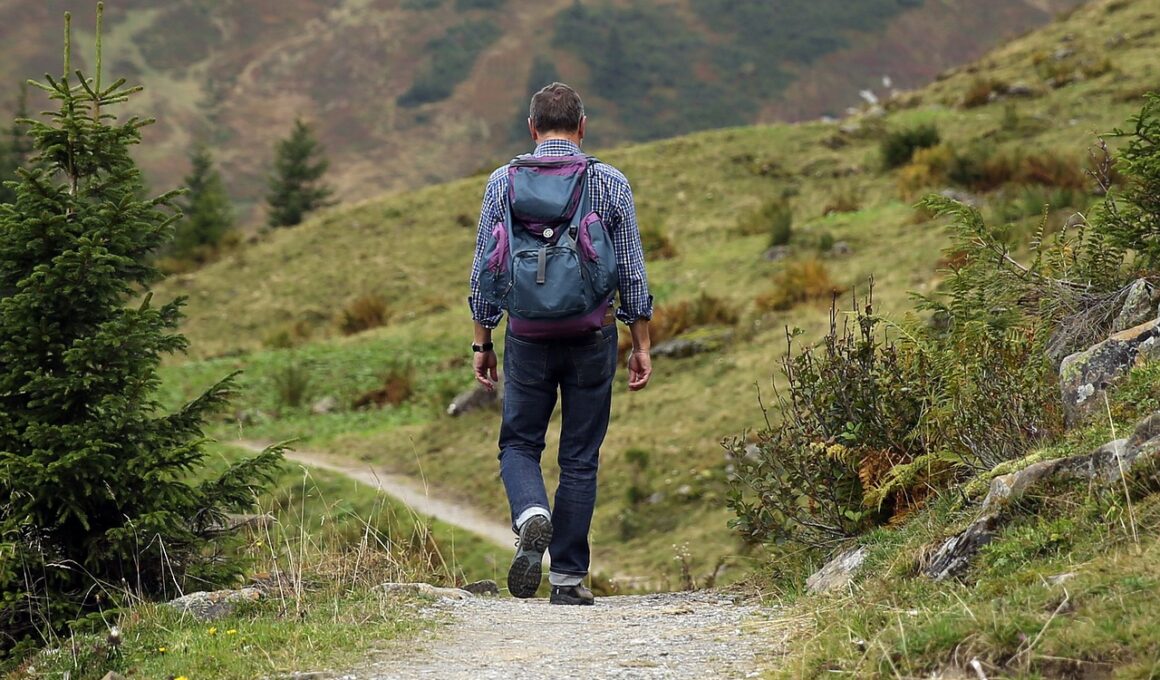Hydration Strategies for Endurance Hiking
Hydration is crucial during endurance hiking. Keeping your body adequately hydrated plays a vital role in preventing fatigue, heat exhaustion, and dehydration. A good rule of thumb is to drink half a liter of water for every hour of moderate activity, but this can vary based on climate and intensity. One helpful strategy is to take regular sips, rather than guzzling large amounts at once. This approach allows your body to absorb the fluid more efficiently. Consuming electrolytes becomes important as well, especially when sweating profusely. You can carry electrolyte tablets or pre-made sports drinks to replenish minerals lost through sweat. Even the food you take on your hiking adventure can help with hydration; fruits like watermelon and oranges are excellent choices. It’s essential to plan your hydration strategy before you go hiking, including identifying water sources along your route, if possible. Use a hydration backpack, which makes drinking while hiking much easier. By ensuring proper hydration, you will be better prepared to tackle the challenges of endurance hiking and enjoy the trekking experience.
During longer hikes, timing your hydration is equally important. Aim to drink small amounts consistently throughout your hike rather than waiting until you feel thirsty. Thirst can often be a sign that you are already dehydrated. Investing in a quality hydration system that allows for easy access while walking can make a significant difference. Many hydration packs come with built-in tubes that may assist in convenient sipping, offering a continuous flow of water without breaking your hiking rhythm. Moreover, keep an eye on the weather, as heat will require increased fluid intake. In humid conditions, your body will lose moisture at a different rate than in dry climates. This means adaptation is crucial for your hydration strategy. You should also consider potential altitude effects that can accelerate dehydration. Be sure to factor in significant elevation changes during your hike. Understanding these nuances can help you better prepare your hydration plan, resulting in a more enjoyable and successful trekking experience. Remember, the right hydration strategy tailored to your hiking environment is key for achieving your endurance goals.
Choosing the Right Hydration Products
Choosing the right hydration gear can enhance your hiking experience significantly. The market offers various hydration solutions, including bottles, bladders, and packs. It is essential to evaluate each option based on your hiking style and duration. For shorter hikes, a durable water bottle may suffice. But as hikes become longer or more strenuous, investing in a hydration bladder or a reservoir backpack becomes beneficial. These options often hold more liquid, ensuring that you won’t run out of water mid-hike. Those who hike in remote areas should consider portable water filters or purification tablets. This adds an additional layer of safety, as it allows you to refill from natural water sources along the trail. Aside from functionality, comfort is key; specially designed hydration packs are often equipped with adjustable straps to prevent bouncing. They also enhance breathability, allowing for better adjustment to your body’s temperature. Furthermore, think about ease of cleaning your hydration systems, as proper hygiene is essential for keeping your health intact on long adventures.
Hydration strategies extend beyond just carrying water; understanding when to hydrate is critical as well. Factors such as the intensity and duration of your hike directly influence your water needs. During prolonged activities, aim to consume water every 15 to 20 minutes, ensuring a steady fluid intake. In addition, consider the type of terrain you will encounter. Steep climbs will require extra energy and hydration than flat surfaces, so adjust your intake accordingly. Monitoring your urine color can serve as an excellent indicator of hydration status; light straw indicates proper hydration while dark yellow suggests a need for more fluids. Always stock up on supplies, as it’s always better to have extra water than run low. Bringing a small insulated container can keep your drinks cool during warm hikes, making water feel refreshing. During challenging hikes, enjoying frequent hydration breaks can also serve as an excellent opportunity to rest, catch your breath, and take in your surroundings. Proper hydration can not only sustain you physically but also enhance your overall hiking experience as well.
The Importance of Electrolytes
Electrolytes play a critical role in hydration, especially for endurance hikers. These vital minerals, including sodium, potassium, and magnesium, help regulate fluid balance and nerve function. When sweating occurs, you lose not just water but also electrolytes, making it essential to replace them during long hikes. Consuming electrolyte-enhanced drinks or snacks during your trail time ensures that your body can maintain optimal hydration levels. Sports drinks and electrolyte tablets are handy options for replacing lost electrolytes while hiking. Often, you can mix these with water to keep your hydration lightweight and manageable. Additionally, some natural food options can replenish electrolytes like bananas for potassium or salted nuts for sodium. Understanding your body’s unique needs is crucial, as heavy sweaters may require additional replenishment. Observing your body’s signals will inform whether you need more fluids or electrolytes at different points during your hike. Evaluating the foods you pack beforehand can help maintain energy levels and stabilize hydration. In summary, the right focus on electrolytes significantly enhances endurance performance on long hikes.
In addition to hydration products and electrolytes, planning where to refill is equally important. Be aware of potential water sources during your hike. Researching your route ahead of time will help identify lakes, rivers, or streams. Carrying a portable water filter can be a game changer; they allow you to safely drink from natural sources while hiking. However, always ensure you are following the environmental guidelines of the area you are hiking. To avoid littering, utilize reusable containers and clean up after yourself. Implementing a systematic approach to hydration will lead to a successful hiking trip, allowing you to enjoy the beautiful scenery. Tracking your daily water consumption leading up to your hiking day can also be an effective strategy. Adequately hydrating before the trip will prepare your body for what is to come. Lastly, remember that personal preferences do vary, so adapt your methods to what suits you best when it comes to hydration, comfort, and enjoyment on the trails.
Tips for Staying Hydrated in Various Conditions
Consider your environment when planning your hydration strategy for hiking. In hot or dry climates, your body tends to lose water at a faster rate, so you need to drink more frequently. Conversely, cold weather can lead to lower thirst levels, but hydration remains essential since your body still loses moisture through breathing and exertion. It’s important to stay aware of fluid needs in all conditions. One effective way to remember to drink enough water is to set reminders on your phone or smartwatch. Hydration packs can be particularly helpful, enabling you to sip easily without stopping. Carrying water in multiple ways also works; having both a bladder and a bottle can ensure that you have access to fluids. Being cautious with alcoholic beverages and caffeine before and during hikes is also vital, as these can lead to increased dehydration. To close, no matter the environment, recognizing and adapting to the signals your body sends regarding hydration could transform your hiking experience for the better.
Ultimately, successful hydration during endurance hiking requires preparation, understanding your body, and adapting plans. Focusing on consistent fluid intake, coupled with the strategic use of electrolytes and appropriate gear, enhances performance. Each hiker must ultimately listen to their body and assess needs as they progress. Planning is key; researching trails for water resources and sourcing appropriate hydration systems will ensure that you enjoy your hike while remaining safe. Additionally, engaging in practice hikes before a big trip can help identify personal fluid requirements as you become more familiar with your body’s responses to exertion. Creating a hydration schedule based on experience will lead to more enjoyable outings. Make sure to encourage fellow hikers to hydrate, fostering a culture of wellness on trails. Keep hydration logs, monitor how often you drink, and pay attention to the quality of your water while hiking. By considering the above, you’ll be more equipped to tackle any hike with an effective hydration strategy, ensuring that you maximize enjoyment and minimize risks during your expedition.


